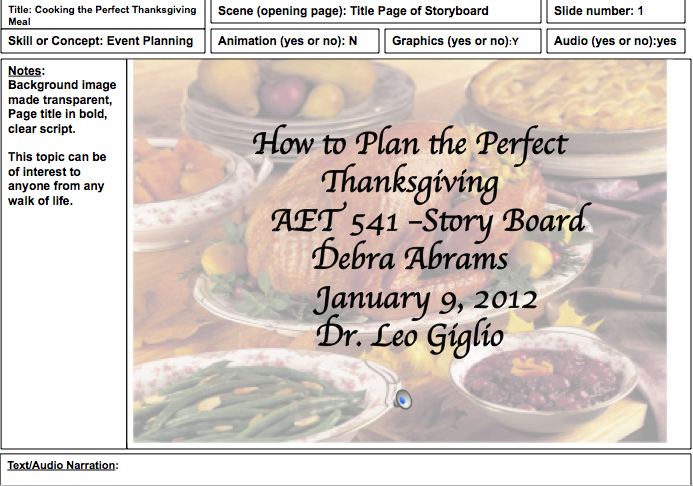A story-board bridges the gap between a concept for curriculum and the development and introduction of that curriculum. University of Phoenix's, AET-541 -- E-Learning, provides the Graduate learner with the ability to do just that, while incorporating the principles of e-learning into a comprehensive presentation of coursework material.
My story-board, designed to provide views and users with the ability to create a successful and innovative, albeit, classic Thanksgiving meal, utilizing the very principles of e-learning that comprised the foundation of AET-541's coursework.

The Principles of E-learning incorporated into my Story-board:
MULTI-MEDIA PRINCIPLE -- By combining both words/text and images/graphics, people form associations that enhance learning and engage the learner. Laden with colorful and thematic background slide images and colorful graphics that enhanced the messages within the slides, the Multimedia principle was effectively utilized.
SEGMENTING PRINCIPLE - By segregating each lesson concept into individual slides rather than presenting the material in a continuous unit, students are better apt to retain the information presented, and compile each segment of the lesson plan into one comprehensive theory of practice.
Pre-training principle: It is essential the concept and segment labels are clearly utilized to allow for student recognition and retention. Pre-training included in my presentation was present in the single slide descriptions of events, references to different styles of recipes, and basic terminology, such as defrosting, roasting, menu, etc.
Coherence principle: Use of the coherence principle ensured that no extraneous words, sounds, or pictures were included in my story-board presentation so as not to overwhelm the student or viewer.
Redundancy principle: Was practiced by selecting animation and on-screen text rather than combining the two with narration as well! Simplicity can take a learner much farther than a too busy screen full of repeated principles and ideas.
Personalization principle: By keeping the text verbiage causal and relatable, the interest of the student is retained the a higher level of student engagement can ensue.
RESEARCHED BASED GUIDELINES
Research in any context is integral to effective learning. By integrating research based guidelines into my storyboard, such as utilizing various categories for choosing recipes and crafts, evaluating individual user/student need to access turkey size and portion, and make effective use of the assessment and evaluative template, research based guidelines were met, therein additionally enhancing learner productivity.
Simulations or Games?
In a learning environment designed around cooking or event planning, there isn't much room for games, however, some simulations could absolutely enhance learning while integrating a whole new level of creativity into the curriculum. Using an interactive template through which to more effectively plan a meal timeline, or even decorate a room and set a table in a simulated environment where "pieces" could be moved around in game fashion, learners could truly integrate their own styles of meal preparation and do trial runs of the event they are planning.

